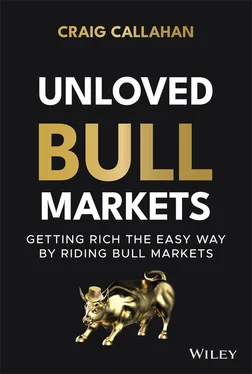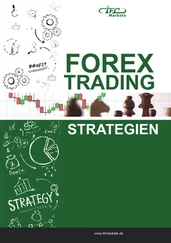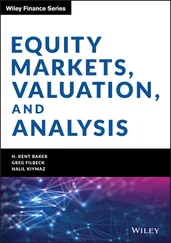Craig Callahan - Unloved Bull Markets
Здесь есть возможность читать онлайн «Craig Callahan - Unloved Bull Markets» — ознакомительный отрывок электронной книги совершенно бесплатно, а после прочтения отрывка купить полную версию. В некоторых случаях можно слушать аудио, скачать через торрент в формате fb2 и присутствует краткое содержание. Жанр: unrecognised, на английском языке. Описание произведения, (предисловие) а так же отзывы посетителей доступны на портале библиотеки ЛибКат.
- Название:Unloved Bull Markets
- Автор:
- Жанр:
- Год:неизвестен
- ISBN:нет данных
- Рейтинг книги:3 / 5. Голосов: 1
-
Избранное:Добавить в избранное
- Отзывы:
-
Ваша оценка:
- 60
- 1
- 2
- 3
- 4
- 5
Unloved Bull Markets: краткое содержание, описание и аннотация
Предлагаем к чтению аннотацию, описание, краткое содержание или предисловие (зависит от того, что написал сам автор книги «Unloved Bull Markets»). Если вы не нашли необходимую информацию о книге — напишите в комментариях, мы постараемся отыскать её.
Unloved Bull Markets: Getting Rich the Easy Way by Riding Bull Markets
Unloved Bull Markets
Unloved Bull Markets
Unloved Bull Markets — читать онлайн ознакомительный отрывок
Ниже представлен текст книги, разбитый по страницам. Система сохранения места последней прочитанной страницы, позволяет с удобством читать онлайн бесплатно книгу «Unloved Bull Markets», без необходимости каждый раз заново искать на чём Вы остановились. Поставьте закладку, и сможете в любой момент перейти на страницу, на которой закончили чтение.
Интервал:
Закладка:
Figure 1.6 Cumulative Return 2009–2019
Does Rate of Return Matter?
You bet it does. From the low on March 9, 2009, to the peak on February 19, 2020, the S&P 500 Index gained at an annual rate of 18.3%. We will not use that for this example because it was above average and exceptional. Let's tone it down and use 10% per year, right near the historic average for equities. Figure 1.7shows the growth of $1.00 over twenty years at 10% per year. It also shows the growth at 5% per year, a rate slightly above what the public fund pension plans earned during the bull market.
Of course, for the public funds the starting amount could easily be $1 billion, so after twenty years there is a $4 billion gap for each billion invested. Even after ten years the gap is almost $1 billion per billion invested. For an individual investor, if the starting amount is $100,000 the difference is over a $400,000 after twenty years. The same math applies to financial advisors for whom the primary determinant of the value of their practice is assets under management. The higher returns earned by the investors, the more the value of the practice grows. Rate of return and participating in bull markets matter because if the goal for retirement is to buy a residence in a tropical location or to travel, the seller of the residence or the travel agent doesn't take risk-adjusted returns. They take money. If the investor can tolerate a little volatility, the market can do the heavy lifting to get to retirement goals.

Figure 1.7 Compounding at 10% and 5%
A couple of years before the end of the eleven-year bull market, I was working out at my fitness center in Naples, Florida. A stock market channel was on most of the TVs and the market was up that day. One retired fellow joked to his buddies, “If the stock market keeps going up, I'll actually be able to afford my life style.”
Top Ten Reasons I Missed the Bull Market
Throughout this multiyear bull market we wrote papers addressing concerns such as unemployment, inflation, deflation, double-dip recession, rising interest rates and monetary policy, and so on that were keeping investors from being invested. These conditions will be addressed in more depth in later chapters. Our presentations were logical and full of data and statistics, but we suspect not successful in getting investors to overcome their fears. In 2015, we tried a different approach and poked fun at investors who were missing out on the bull market. We borrowed from David Letterman and his top-ten lists that he used on his “Late Night Show.” We could not limit the list to ten, so we called it “The Top 15 Reasons I Missed the Bull Market.” Here they are as written in 2015:
1 15. I didn't notice S&P 500 earnings have grown 107% from 2008.
2 14. After 2008, I changed my risk tolerance.
3 13. I am stuck in the 1970s and thought inflation would come back and interest rates would rise.
4 12. I was waiting for unemployment to get below 5%.
5 11. I bought gold instead of equities.
6 10. I didn't like the bailouts.
7 9. I don't understand the Federal Reserve and thought the government was “printing money.”
8 8. I forgot every economic recovery is different and I was waiting for housing to recover.
9 7. I heard Fed easing was like “pushing on a string.”
10 6. I saw a head and shoulders top-forming a few times.
11 5. I thought P/E ratios were too high.
12 4. I was told we are in a seventeen-year secular bear market.
13 3. I worried about deflation and Greek sovereign debt.
14 2. My accountant told me I didn't need huge capital gains.
And the number one reason I missed the bull market of the last six years is:
1 1. I really like earning nothing on CDs.Some of these will be addressed in later chapters. Thanks, David!
Unloved? Why?
Figure 1.8is the S&P 1500 Index from January 30, 2009 (about one month before the bottom) through the peak February 2020. Impressive, as even a cursory look boggles the mind. There were a few dips and pauses along the way but with 20/20 hindsight it appears it would have been easy to just buy and hold and go for the profitable ride. So why did investors net redeem out of equity mutual funds? Why was investor sentiment mostly below average? Why did public funds reduce their equity exposure as a percent of assets? What was happening that kept investors from embracing this bull market like they did previous bull markets?

Figure 1.8 S&P 1500 Index 1/30/09–2/19/20
Throughout the eleven years there was no shortage of skeptical, bearish commentary in the financial media and from advisory services and professional money managers. As for the books, one of the early ones, first published in 2010 and updated in 2012, predicted a decade of slow economic growth and deflation based on deleveraging. Regarding stocks, the author predicted falling P/E ratios, muted price appreciation, and recommended avoiding stocks related to big ticket consumer purchases, consumer lending, and homebuilding. He favored buying Treasury bonds, consumer staples, and North American energy. ( Chapter 2will confirm how wrong these predictions and recommendations were.) A second book in 2014 based its view on demographics and predicted the economy would fall off a cliff and that the stock market would be terrible from 2014 to 2019. The author warned that you needed to prepare for the worst downturn and crash of your lifetime beginning in early to mid-2014. A third book in 2018 labeled the bull market “fake” and claimed we could fake a bull market for just a short, limited amount of time. The author based the potential for a severe market reversal on global debt and Federal Reserve policy. Rather than fake, a 530% gain in eleven years and a 765% gain through August 2021 seems very real to an investor who participated. Did the books influence investors and contribute to their bearish sentiment or did investors’ predetermined bearish position simply make them receptive the gloom and doom theme? Maybe a little of both.
As for regular commentary, there were fears of higher inflation, deflation, double-dip recession, and rising interest rates at various times along the way. Early on many skeptics didn't like what they called “bailouts.” Some thought the easy monetary policy made the bull market phony, fabricated, and unsustainable. Some investors did not think the unemployment rate was dropping fast enough. Negative interest rates, new and puzzling for this generation, scared many investors away. Valuation seemed to be a problem for many because there were frequent claims that stocks were too expensive. Chapter by chapter, let's look into these situations and see if there was a lesson to be learned. After all, there will be more bull markets in the future, and we don't want to miss out on them.
Конец ознакомительного фрагмента.
Текст предоставлен ООО «ЛитРес».
Прочитайте эту книгу целиком, купив полную легальную версию на ЛитРес.
Безопасно оплатить книгу можно банковской картой Visa, MasterCard, Maestro, со счета мобильного телефона, с платежного терминала, в салоне МТС или Связной, через PayPal, WebMoney, Яндекс.Деньги, QIWI Кошелек, бонусными картами или другим удобным Вам способом.
Интервал:
Закладка:
Похожие книги на «Unloved Bull Markets»
Представляем Вашему вниманию похожие книги на «Unloved Bull Markets» списком для выбора. Мы отобрали схожую по названию и смыслу литературу в надежде предоставить читателям больше вариантов отыскать новые, интересные, ещё непрочитанные произведения.
Обсуждение, отзывы о книге «Unloved Bull Markets» и просто собственные мнения читателей. Оставьте ваши комментарии, напишите, что Вы думаете о произведении, его смысле или главных героях. Укажите что конкретно понравилось, а что нет, и почему Вы так считаете.











